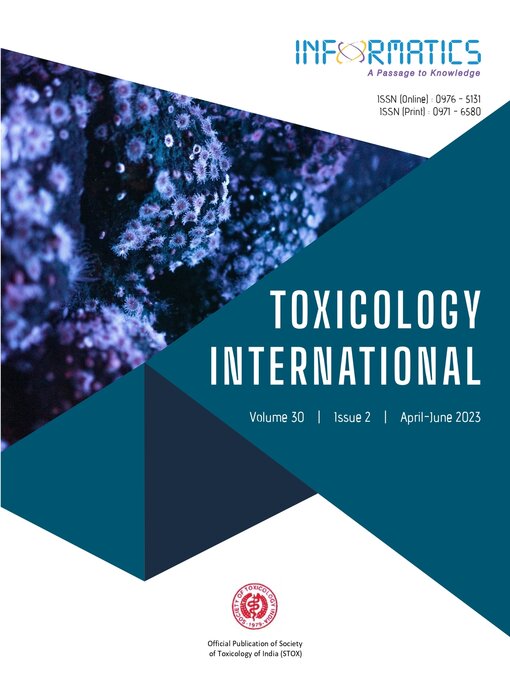Toxicity Studies of Trayodashang guggulu, A Classical Ayurvedic Formulation in Experimental Animals
DOI:
https://doi.org/10.18311/ti/2023/v30i2/30617Keywords:
Acute Toxicity, Dose Range Finding Study, Sub-chronic Toxicity Study, Toxicity Study, Trayodashang gugguluAbstract
The present study was undertaken to evaluate the Maximum Tolerated Dose and No Observed Adverse Effect Level of Trayodashang guggulu (TG), an Ayurvedic classical formulation, in Wistar rats. TG was administered orally to Wistar rats in as single dose (2000 mg/kg body weight) in an acute toxicity study. Ninety days repeated dose oral toxicity (subchronic) study was carried out by using three dose levels (250, 500 and 1000 mg/kg body weight) administered orally daily for 90 consecutive days and derived from 28 days dose range-finding study. In acute and subchronic toxicity studies, animals were observed for general clinical signs, mortality, weekly body weight changes, weekly feed intake, weekly water intake, blood biochemical investigation, haematological parameters, and gross pathological and histological investigations. In an acute toxicity study, the dose level of 2000 mg/kg of TG was found to be safe when given at a single dose. In the dose rangefinding study and subchronic toxicity study TG was found to be safe at all tested dose levels. No significant changes in food and water consumption, haematological and blood biochemical parameters were noticed at any dose level in both studies. No major changes were noticed during histopathological evaluation in ninety days repeated dose oral toxicity study. The study concluded that the Maximum Tolerated Dose of TG was found at 2000 mg/kg body weight and the No Observed Adverse Effect Level was found at 1000 mg/kg in Wistar rats.
Downloads
Published
How to Cite
Issue
Section
Accepted 2023-02-17
Published 2023-05-19
References
The Ayurvedic Formulary of India, Part I, 2nd Revised Edition. New Delhi: Controller of Publication, Ministry of Health and Family Welfare, Govt. of India. 2004. http:// www.ayurveda.hu/api/API-Vol-1.pdf
Rathod HS, Sawant RS. Evaluation of efficacy of Trayodashang guggulu in management of Cervical spondylosis (Manyagata vata). J Biol Sci Opin. 2013; 1:65–9. https://doi.org/10.7897/2321-6328.01206 DOI: https://doi.org/10.7897/2321-6328.01206
Kidd BL, Langford RM, Wodehouse T. Arthritis and pain. Current approaches in the treatment of arthritic pain. Arthritis Res Ther. 2007; 9(3):214. PMid: 17572915. PMCid: PMC2206347. https://doi.org/10.1186/ar2147 DOI: https://doi.org/10.1186/ar2147
Saper RB, Kales SN, Paquin J, Burns MJ, Eisenberg DM, Davis RB, Phillips RS. Heavy metal content of ayurvedic herbal medicine products. JAMA. 2004; 292:2868–73. PMid: 15598918. https://doi.org/10.1001/jama.292.23.2868 DOI: https://doi.org/10.1001/jama.292.23.2868
Lavekar GS, Ravishankar B, Gaidhani S, Shukla VJ, Ashok BK, Padhi MM. Mahayograj guggulu: Heavy metal estimation and safety studies. Int J Ayurveda Res. 2010; 1:150–8. PMid: 21170206. PMCid: PMC2996572. https:// doi.org/10.4103/0974-7788.72486 DOI: https://doi.org/10.4103/0974-7788.72486
OECD guideline for Testing of Chemicals 423. Acute Oral Toxicity - Acute Toxic Class Method. OECD. 2001; 1-14. https://www.oecd-ilibrary.org/ environment/test-no-423-acute-oral-toxicity-acute-toxicclass- method_9789264071001-en
Gautam MK, Singh A, Rao CV, Goel RK. Toxicological evaluation of Murraya paniculata (L.) leaves extract on rodents. Am J Pharmaco Toxicol. 2012;7(2):62–7. https:// doi.org/10.3844/ajptsp.2012.62.67 DOI: https://doi.org/10.3844/ajptsp.2012.62.67
Gautam MK, Goel RK. Toxicological study of Ocimum sanctum Linn Leaves: Hematological, Biochemical, and Histopathological Studies. J Toxicol. 2014: Article ID 135654. PMid: 24616736. PMCid: PMC3927567. https:// doi.org/10.1155/2014/135654 DOI: https://doi.org/10.1155/2014/135654
OECD guideline for the Testing of Chemicals 408, adopted on 21st September, 1998. Repeated Dose 90-days Oral Toxicity Study in Rodents. OECD. 1998;1–10. https://www. oecd.org/env/ehs/testing/Revision%20TG%20408%20 2018.pdf
Hajja G, Bahlouli A. Medicinal plants in the prevention and treatment of rheumatoid arthritis. MOJ Bio Avail. 2018; 5(1):60–4. https://doi.org/10.15406/mojbb.2018.05.00084 DOI: https://doi.org/10.15406/mojbb.2018.05.00084
Patel MG, Pundarikakshudu K. Anti-arthritic activity of a classical Ayurvedic formulation vatari guggulu in rats. J Tradit Complement Med. 2015; 6(4):389–94. PMid: 27774424. PMCid: PMC5067862. https://doi.org/10.1016/j. jtcme.2015.08.007 DOI: https://doi.org/10.1016/j.jtcme.2015.08.007
Taru P, Abhyankar M, Undale V, Bhosale A. Acute and subacute toxicity studies on sho-dhana processed guggul. Int J Pharm Sci Res. 2013; 4(2):796–9. https://doi.org/10.13040/ IJPSR.0975-8232
Kumar S, Kumar R, Srivastava R, Rai RK, Sasty JLN, Gupta A. Sub chronic oral toxicity study of a herbo-mineral ayurvedic formulation swarna guggulu in Wistar rats. Ind J Nat Pro Res. 2018; 9(3):244–52. http://op.niscair.res.in/ index.php/IJNPR/article/view/20869/465464887
Gautam MK, Gangwar M, Singh SK, Goel RK. Effects of Azardirachta indica on Vascular Endothelial Growth Factor and Cytokines in Diabetic Deep Wound. Planta Medica. 2015; 81(09):713–21. PMid: 26069952. https://doi. org/10.1055/s-0035-1545917 DOI: https://doi.org/10.1055/s-0035-1545917
Wanjari M, Yadav M, Dey YN, Sharma D, Srivastava B, Jamdagni S, Gaidhani SN, Gautam MK. Assessment of systemic toxicity of Laghu Vishagarbha taila, an Ayurvedic medicated oil formulation after dermal exposure. Toxicology Res. 2021; 11(1):32–41. PMid: 35237409. PMCid: PMC8882792. https://doi.org/10.1093/toxres/ tfab104 DOI: https://doi.org/10.1093/toxres/tfab104
 Manajit Bora
Manajit Bora







